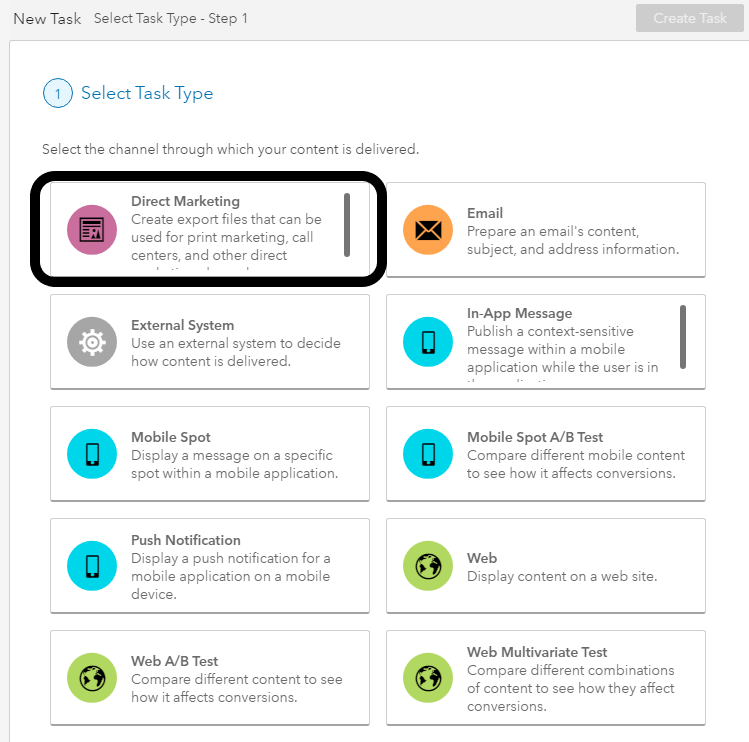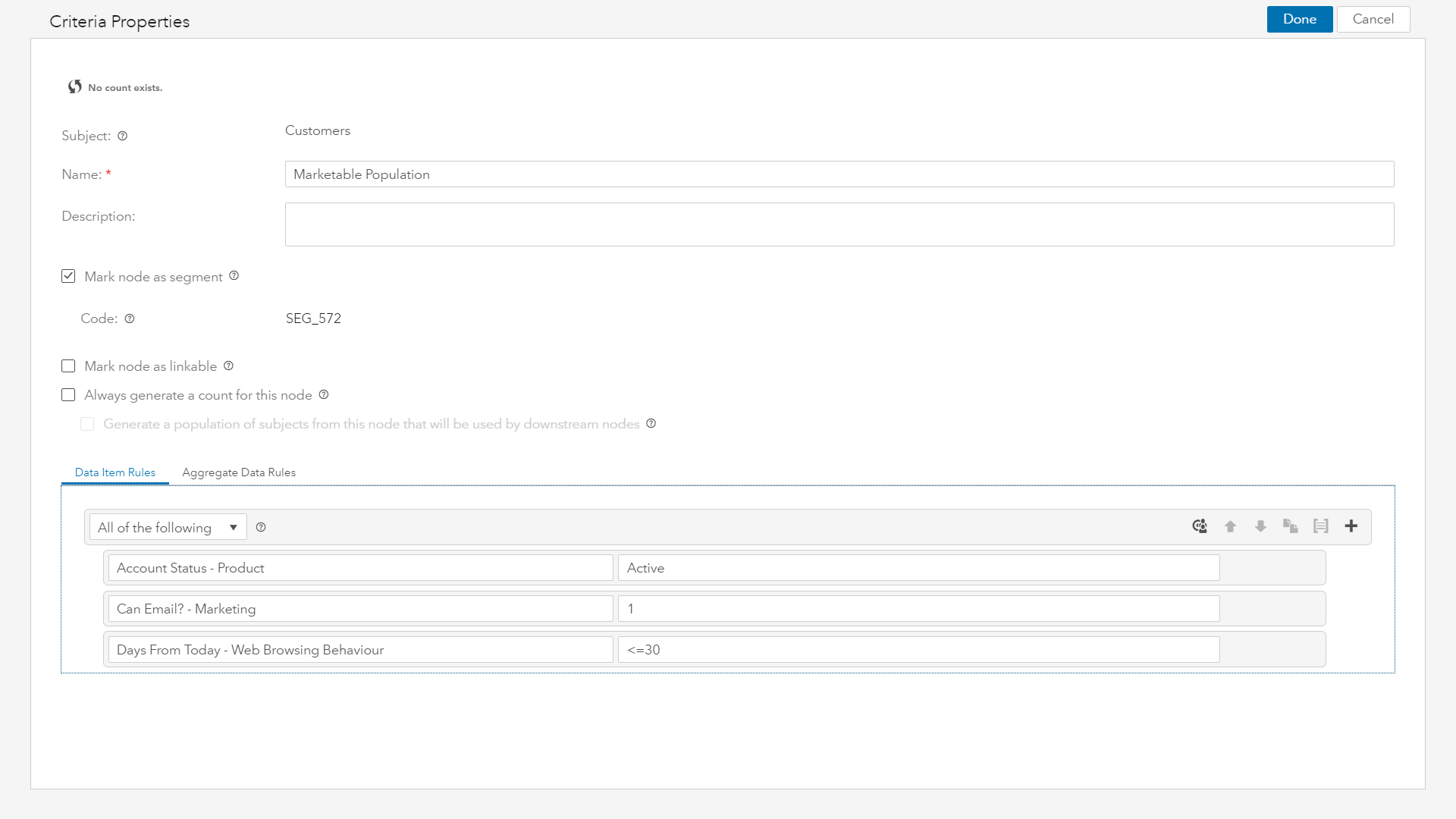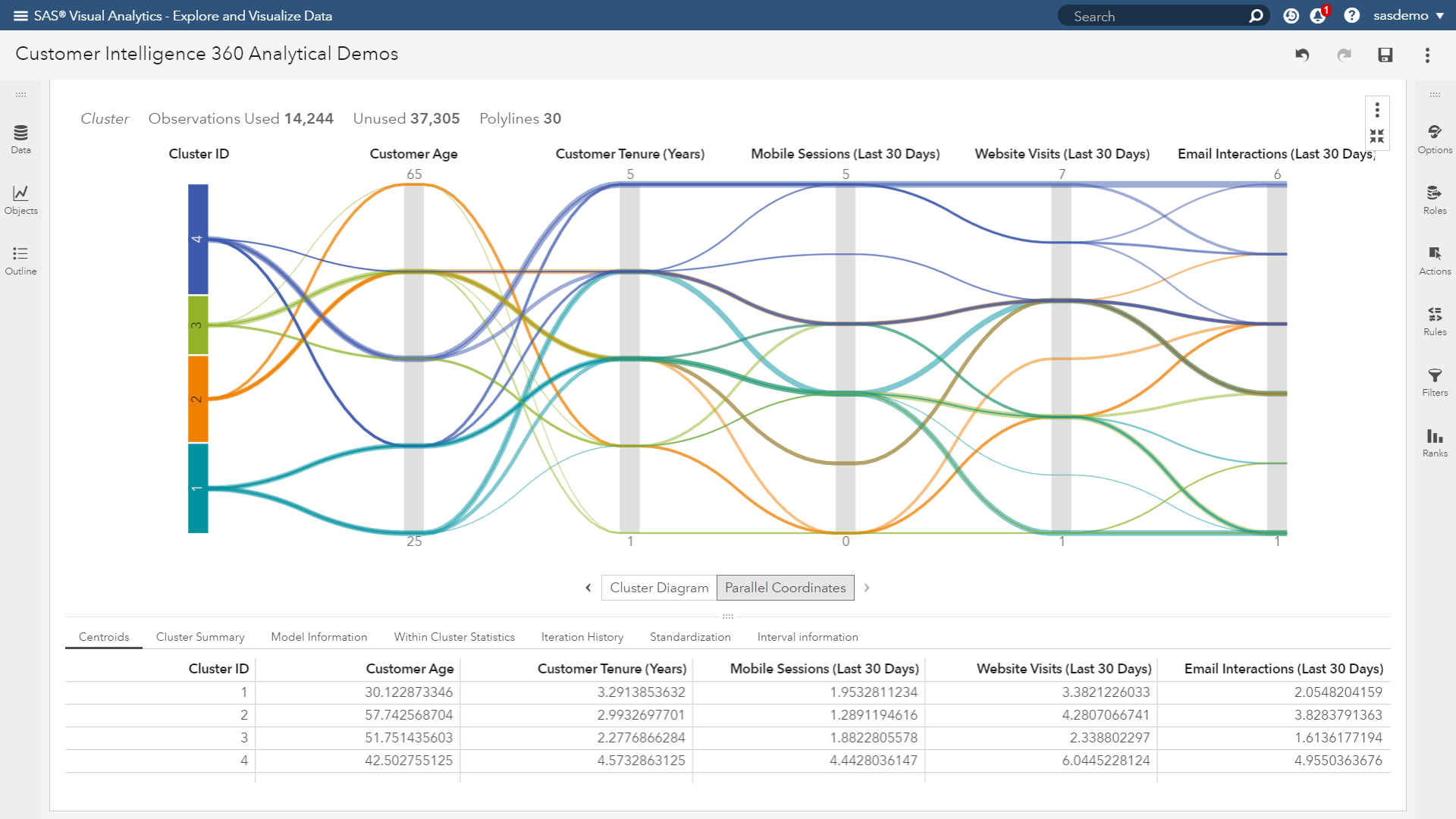- Home
- /
- SAS Communities Library
- /
- SAS Customer Intelligence 360: Hybrid marketing, campaign management &...
- RSS Feed
- Mark as New
- Mark as Read
- Bookmark
- Subscribe
- Printer Friendly Page
- Report Inappropriate Content
SAS Customer Intelligence 360: Hybrid marketing, campaign management & analytic's last mile
- Article History
- RSS Feed
- Mark as New
- Mark as Read
- Bookmark
- Subscribe
- Printer Friendly Page
- Report Inappropriate Content
It’s challenging to argue that the marketing industry has ever had greater access to data than today. However, data alone does not drive your marketing organization. Decisions do. And with all the recent hype regarding the potential of AI, a successful cross-channel campaign is propelled by a personalized, data-driven approach injected with machine learning.
According to my SAS peers Andy Bober and Steve Hill in their SAS Global Forum 2019 white paper:
“Despite the challenges of complex data privacy regulations, rising consumer expectations, and always-on competition, marketing technology is now starting to deliver on many long-time promises such as one-to-one marketing and customer journey management.
But there are still hurdles to address. As consumers, we want businesses to consistently treat us as if they know us, regardless of the time, circumstances, or place. As marketing technologists, we want to leverage the flexibility afforded by Software as a Service (SaaS) and cloud computing, but we don’t want to be the next business to be in the news for a data breach or a General Data Protection Regulation (GDPR) violation. Hybrid marketing addresses these critical dissonances.”
Hybrid marketing background
Hybrid marketing can be summarized by two areas:
The concept of integrated marketing evolved when digital marketing matured and brands recognized these two disciplines could no longer operate in silos. Over the past decade, the industry hasn’t fallen short of buzzwords to generate excitement about the potential.
This year, the concept of AI (or artificial intelligence) is a great example. Everyone is talking about it, few really know how to do it, everyone thinks everyone else is doing it, so everyone claims they are doing it. Unfortunately, a lot of what one hears about AI is sensationalized. Indeed, AI is over-hyped. But AI is also real and powerful, and the marketing space is craving it.
However, customers don’t care how complicated and convoluted the martech ecosystem is. The frustration with the industry overall has led to personal privacy legislation, such as GDPR, which places more responsibility on brands to protect their customers’ data. With that said, how can marketers interact with their customers and prospects in a respectful yet personal manner?
Hybrid marketing combines the capabilities of direct and digital marketing in a single platform. Organizational silos break down, enabling analysts and channel managers to leverage online and offline data to improve customer journeys, and the efficacy of their efforts.
How does hybrid marketing work?
There are important considerations when a technology vendor requires a brand to on-board their managed customer data and intellectual property into a cloud solution.
- Data duplication
- Synchronization
Unless your brand is moving all of their operational and marketing systems to a single location, this will always be a challenge. Instead of requiring brands to go down this path, SAS Customer Intelligence 360 provides a secure, Web socket-based connection between your chosen data management environment and our marketing cloud platform.
The connections are labeled as an API gateway of agents and provide a plug-in and SDK framework that allow integration with any external system. While not the focus of this article, readers can learn more about the agent framework by reviewing this white paper by Toshi Tsuboi and Stephen Cuppett.
Moving on, rather than requiring the movement and duplication of any of your brand’s managed first-party customer data to SAS Customer Intelligence 360, the hybrid marketing design allows mapping a customer identity from your data repository to an anonymous hashed identity in the SAS cloud. For clarity, your managed environment can be on-premises, hosted by another company, or stored in a cloud system. It’s your choice and you control your data.
Let’s look at a segmentation example for multi-touchpoint targeting. A brand has a large volume of customers in their on-prem database, including Suneel and Jeri, who are active customers, opted-in for email communications, interacted with the brand online in the last 30 days, and have been scored by a machine learning model for their propensity to convert.
As with most CRM databases, countless attributes are available ranging from demographics, psychographics, house-holding, transactions, analytical scores, third-party appends, etc.. What has lacked in these environments historically is the availability of structured online user behavior, which has typically been in a silo within an external cloud platform. Not anymore.
A key value prop is there are no personal identifiers for Suneel or Jeri in SAS Customer Intelligence 360. Instead, Suneel is mapped by an anonymous ID, ABC123, and Jeri by XYZ789. If a marketer wants to target a segment, the platform can query information residing in the brand’s CRM managed database, as well as leverage cloud-stored data captured from owned digital media (web, mobile app, etc.).
This is similar to traditional campaign management (or marketing automation) processes, except instead of requiring your organization to duplicate all your first-party offline data in the vendor’s cloud solution, the individuals who meet your use case’s targeting criteria are simply mapped to a segment in SAS Customer Intelligence 360. No Suneel, no Jeri, nor any other personal information about them, just ABC123 and XYZ789, along with other customer-linked anonymous identities that are now associated with your defined segment.
Hybrid marketing and analytics
Another massive differentiator in favor of hybrid marketing is the availability of your preferred machine learning technology to add value to your campaign management workflow. It is no longer a debate that analytically-driven decisions are better in driving measurable impact.
The hype behind AI is primarily focused on augmenting decisions, process, natural language processing and computer vision. The result is a set of trends made up of:
- Algorithms producing better analytics and accuracy.
- Automation of machine learning aligned to more productivity.
- Embedded analytics making AI more impactful and consumable.
- Human-like interfaces creating approachability.
What happens when AI becomes useful for your brand? It effectively can be renamed from artificial intelligence to analytical integration of any internal process or external customer experience your organization facilitates. But there are barriers to AI adoption, including the lack of:
- Talent
- Stakeholder buy-in
- End-to-end solutions
- Data strategy
Transforming hype into reality for AI must focus on data, discovery, and deployment. Brands cannot survive on classroom science projects, and taking action enabled by AI-enhanced decisions completes the enviable last mile of embedding analytics into personalization strategies using experimentation and testing, recommendation systems, next-best-actions, attribution, segmentation, and journey optimization.
Going back to our segmentation example, let’s take a closer look at the influence of machine learning in the campaign management process. In Image 5 above, the last step of the segment mapping was the application of algorithmic clustering. But how were these clusters created?
Within SAS, analysts can perform artisanal modeling using programmatic or visual user interfaces. Given that customer behavior varies over time when thinking about segmentation, there isn’t one algorithm that rules them all. Users are offered a variety of techniques to select for both supervised and unsupervised approaches.
Clustering is a method of data segmentation that puts observations into groups that are suggested by the data. The observations in each cluster tend to be similar in some measurable way, and observations in different clusters tend to be dissimilar. Observations are assigned to exactly one cluster. From the clustering analysis, users can generate a cluster ID variable to tag customers for use in campaign management processes.
Let’s walk through a visual k-means clustering example that will transparently showcase how the results are derived and made available for SAS Customer Intelligence 360 to take advantage of.
The first step is to select the analysis object and drop it into the workspace.
Next, users assign attributes to roles, customize model properties (if desired), and the model executes to provide results. In this example, the following attributes are fed into the analysis.
- Customer age
- Customer tenure (years)
- Mobile app sessions (last 30 days)
- Website visits (last 30 days)
- Email interactions (last 30 days)
The analyst wants to identify unsupervised synergies that help explain segment behavior across these online and offline signals. The results include two interactive visualizations worth highlighting.
The cluster diagram (or matrix) displays a two-dimensional visualization of each cluster onto a specified number of effect pairs. These projections are useful for spotting cluster similarities and differences within the plots. Each cluster is assigned a unique color. Although each cluster is unique in n-space, the two-dimensional projections will overlap. It is important to note that every observation (or customer) can belong to exactly one cluster.
Interactivity with the diagram allows users to improve their understanding of any plotted effect pair.
The interpretation of the relationship between customer age and the number of email interactions highlights that four unique segments exist, with two clusters displaying lower levels of engagement through this digital touchpoint. Users can hover over any centroid and obtain displays of each cluster’s mean values for the effect pair.
But what about the “data story” of each cluster? Let me introduce the parallel coordinates plot that enables users to accelerate the understanding of each cluster’s trends. The plot displays data as lines moving through categories and binned measures. The thickness of a line indicates the relative number of observations in that bin.
Wait a minute. This looks like spaghetti. How is this helpful?
Interactively, analysts can restrict the active lines to one or more bins in order to focus on only the data that interests them. In addition, users can adjust the plot to explore the data based on cluster membership, a specified range for one or more variables, or both.
A single click with the visual plot allows the user to focus on Cluster 1. The interpretation (or story) is this group skews younger, moderate tenure, and low to medium engagement levels across web, mobile, and email touchpoints.
Another click leads the user to focus on Cluster 3. The interpretation here is a group aged 35-45 years, and high values of tenure and digital touchpoint engagement. The interactivity doesn’t end there, as a selection of the vertical bar representing age distribution, and the analyst can further filter on customers 40 years of age or greater.

(Image 16: SAS Customer Intelligence 360 - Parallel coordinates plot and isolating cluster 3 aged 40 years or greater)
Hybrid marketing and completing analytic’s last mile
Let’s assume we are feeling confident about the results of our clustering analysis. Now is the time to share the results with the marketing teams who manage campaign management across touchpoints. The audience segments defined in SAS Customer Intelligence 360 can absorb the clusters to improve targeting criteria that can be used for direct, email, web, mobile, or other interaction types.
To begin the transition, the analyst simply needs to score customer (or prospect) records with cluster tags.
Here is an example of what the tagged data would look like.
Rest assured, there are different approaches in making analytically scored data available within (and outside) of SAS beyond a table. What options do analysts have in helping their marketing teams?
- Batch or real-time.
- Invoke the clustering scoring engine (SAS, Python or REST) for external APIs through SAS analytic services.
With the clustering analysis tags now available for the marketer, let’s revisit the segmentation map we referenced earlier.
To create the final step of this segmentation map, a split node allows a user to leverage the prescription.
Once the marketer has finished their targeting, users can schedule segments to run once (or on a recurring basis). If your brand is using a third party (for example, a mail house, print shop, or email services provider) for execution and delivery, the proper export template can be chosen, and the output files with names, addresses, and other personalized information can be sent directly from the environment.

(Image 21: SAS Customer Intelligence 360 - Direct marketing task for audience export to third parties)
None of your brand’s managed data ever enters the SAS Customer Intelligence 360 cloud. Likewise, contacts and responses can be captured and collected without requiring a pass-through in the cloud.

(Image 22: SAS Customer Intelligence 360 – Defining audience export for third party ESPs and Direct Mail letter houses)
To absorb the clustering-enhanced segmentation into the export, users simply need to add the segment(s) as part of the targeting criteria of the export.
Alternatively, SAS Customer Intelligence 360 is not reliant on third party ESPs, and can support email touchpoint delivery itself. The value prop being contact and response tracking is immediately updated in the platform (as opposed to a 24 or 48 hour batch feed that your third party partner sends back), and can benefit downstream personalization when customers interact with your brand across other touchpoints (web, mobile, call center, etc.).
The impact of the hybrid marketing approach with respect to sending email assumes an address must be used by the sender. When SAS Customer Intelligence 360 is used to deliver email, a file that contains addresses, along with any personalization parameters (for example, customer name) required by that email template, is uploaded to the cloud. Once the email is sent, the file is automatically deleted so that no personal data persists.
From a targeting perspective, it’s important to recognize that a defined segment is available across any supported touchpoint (or task) within SAS Customer Intelligence 360. Similar to the direct marketing task example above, the clustering-enhanced segments are available for the email task in a single click.
From a digital marketer’s perspective, the additional customer insight that hybrid marketing
provides is invaluable in terms of improving personalization. Let’s discuss this value prop in the context of customer journeys (or activity maps).

(Image 26: SAS Customer Intelligence 360 - Multi-channel customer journey personalization with Activity Maps)
This example depicts a coordinated series of web, mobile, and email tasks that are designed to meet the goals of a marketing campaign. An activity map uses tasks and events. An activity map charts the customer journeys between tasks, such as sending a particular message through a particular channel, and conditions, such as the primary goal and evaluation periods.
For example, users might use a web task to present an offer on your website.
After allocating creative(s) for the interaction, the hybrid marketing value prop surfaces under targeting.
Attainable at the marketer’s finger tips are:
- Demographics from your managed data environment outside of the SAS Customer Intelligence 360 cloud.
- Analytical segmentation scores, web dimensions and behavior stored inside the SAS Customer Intelligence 360 cloud.
Coming back to the customer journey, users can use a mobile or email task to communicate a discount offer to all users who received an impression of the web task offer within the last week, but didn’t meet the macro-conversion goal.
Importantly, SAS Customer Intelligence 360 isn’t a direct-only or a digital-only offering—it’s a hybrid marketing application that allows marketers to create omni-channel scenarios that span traditional direct and digital channels, along with other customer experience Interactions.
Against a backdrop of accelerating media and technology complexity, evolving privacy regulations, and increasing consumer expectations, hybrid marketing from SAS Customer Intelligence 360 provides a simple but powerful approach to address today’s martech ecosystem.
To learn more about how the SAS platform can be applied to other marketing and customer-centric use cases, check out additional posts here.
SAS Innovate 2025: Call for Content
Are you ready for the spotlight? We're accepting content ideas for SAS Innovate 2025 to be held May 6-9 in Orlando, FL. The call is open until September 25. Read more here about why you should contribute and what is in it for you!
Free course: Data Literacy Essentials
Data Literacy is for all, even absolute beginners. Jump on board with this free e-learning and boost your career prospects.
























